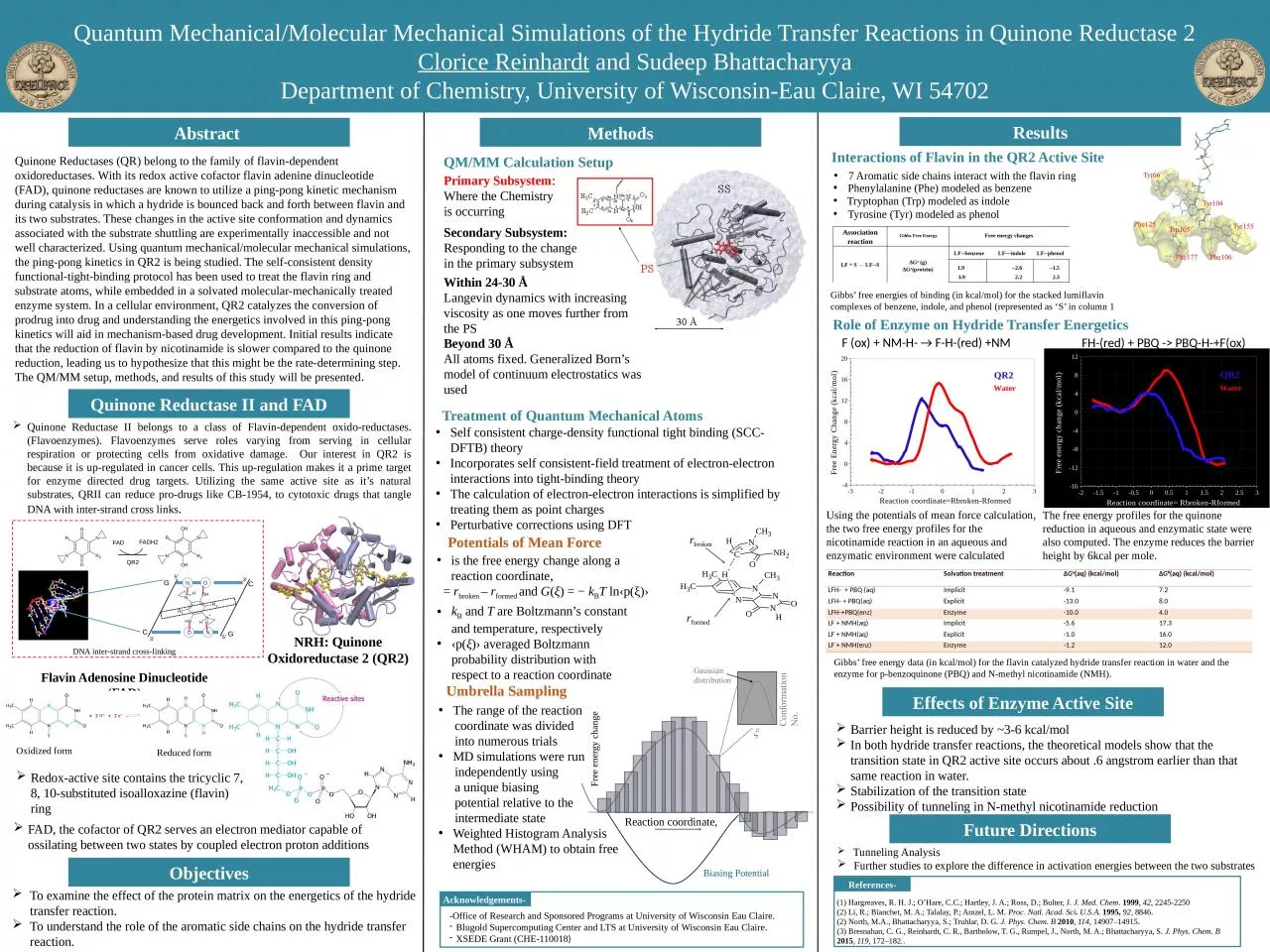

2 Clorice Reinhardt and Sudeep Bhattacharyya Department of Chemistry University of WisconsinEau Claire WI 54702 1 Hargreaves R H J OHare CC Hartley J A Ross D ID: 1044921
Download Presentation The PPT/PDF document "Quantum Mechanical/Molecular Mechanical ..." is the property of its rightful owner. Permission is granted to download and print the materials on this web site for personal, non-commercial use only, and to display it on your personal computer provided you do not modify the materials and that you retain all copyright notices contained in the materials. By downloading content from our website, you accept the terms of this agreement.
1. Quantum Mechanical/Molecular Mechanical Simulations of the Hydride Transfer Reactions in Quinone Reductase 2Clorice Reinhardt and Sudeep BhattacharyyaDepartment of Chemistry, University of Wisconsin-Eau Claire, WI 54702(1) Hargreaves, R. H. J.; O’Hare, C.C.; Hartley, J. A.; Ross, D.; Bulter, J. J. Med. Chem. 1999, 42, 2245-2250(2) Li, R.; Bianchet, M. A.; Talalay, P.; Amzel, L. M. Proc. Natl. Acad. Sci. U.S.A. 1995, 92, 8846. (2) North, M.A., Bhattacharyya, S.; Truhlar, D. G. J. Phys. Chem. B 2010, 114, 14907–14915. (3) Bresnahan, C. G., Reinhardt, C. R., Bartholow, T. G., Rumpel, J., North, M. A.; Bhattacharyya, S. J. Phys. Chem. B 2015, 119, 172–182..References-Acknowledgements--Office of Research and Sponsored Programs at University of Wisconsin Eau Claire.Blugold Supercomputing Center and LTS at University of Wisconsin Eau Claire. XSEDE Grant (CHE-110018)Quinone Reductase II and FADEffects of Enzyme Active Site Tunneling Analysis Further studies to explore the difference in activation energies between the two substratesRedox-active site contains the tricyclic 7, 8, 10-substituted isoalloxazine (flavin) ringFlavin Adenosine Dinucleotide (FAD)Reduced form Oxidized form Quinone Reductases (QR) belong to the family of flavin-dependent oxidoreductases. With its redox active cofactor flavin adenine dinucleotide (FAD), quinone reductases are known to utilize a ping-pong kinetic mechanism during catalysis in which a hydride is bounced back and forth between flavin and its two substrates. These changes in the active site conformation and dynamics associated with the substrate shuttling are experimentally inaccessible and not well characterized. Using quantum mechanical/molecular mechanical simulations, the ping-pong kinetics in QR2 is being studied. The self-consistent density functional-tight-binding protocol has been used to treat the flavin ring and substrate atoms, while embedded in a solvated molecular-mechanically treated enzyme system. In a cellular environment, QR2 catalyzes the conversion of prodrug into drug and understanding the energetics involved in this ping-pong kinetics will aid in mechanism-based drug development. Initial results indicate that the reduction of flavin by nicotinamide is slower compared to the quinone reduction, leading us to hypothesize that this might be the rate-determining step. The QM/MM setup, methods, and results of this study will be presented.Primary Subsystem: Where the Chemistry is occurringQuinone Reductase II belongs to a class of Flavin-dependent oxido-reductases.(Flavoenzymes). Flavoenzymes serve roles varying from serving in cellular respiration or protecting cells from oxidative damage. Our interest in QR2 is because it is up-regulated in cancer cells. This up-regulation makes it a prime target for enzyme directed drug targets. Utilizing the same active site as it’s natural substrates, QRII can reduce pro-drugs like CB-1954, to cytotoxic drugs that tangle DNA with inter-strand cross links.NRH: Quinone Oxidoreductase 2 (QR2)To examine the effect of the protein matrix on the energetics of the hydride transfer reaction.To understand the role of the aromatic side chains on the hydride transfer reaction.Abstract ObjectivesMethodsResultsFuture DirectionsQM/MM Calculation SetupInteractions of Flavin in the QR2 Active SiteRole of Enzyme on Hydride Transfer EnergeticsTreatment of Quantum Mechanical AtomsF (ox) + NM-H- → F-H-(red) +NMFH-(red) + PBQ -> PBQ-H-+F(ox)Association reaction Gibbs Free EnergyFree energy changesLF + S → LF--S∆Go (g)∆Go(protein)LF--benzene LF—indole LF--phenol1.9 3.9 ‒2.62.2 ‒1.52.3Gibbs’ free energies of binding (in kcal/mol) for the stacked lumiflavin complexes of benzene, indole, and phenol (represented as ‘S’ in column 1 Tryptophan (Trp) modeled as indole Tyrosine (Tyr) modeled as phenol Phenylalanine (Phe) modeled as benzene 7 Aromatic side chains interact with the flavin ring Barrier height is reduced by ~3-6 kcal/molIn both hydride transfer reactions, the theoretical models show that the transition state in QR2 active site occurs about .6 angstrom earlier than that same reaction in water. Stabilization of the transition statePossibility of tunneling in N-methyl nicotinamide reductionFAD, the cofactor of QR2 serves an electron mediator capable of ossilating between two states by coupled electron proton additionsUsing the potentials of mean force calculation, the two free energy profiles for the nicotinamide reaction in an aqueous and enzymatic environment were calculated The free energy profiles for the quinone reduction in aqueous and enzymatic state were also computed. The enzyme reduces the barrier height by 6kcal per mole. ReactionSolvation treatment∆Go(aq) (kcal/mol)∆G#(aq) (kcal/mol)LFH- + PBQ (aq)Implicit-9.17.2LFH- + PBQ(aq)Explicit-13.08.0LFH-+PBQ(enz)Enzyme-10.04.0LF + NMH(aq)Implicit-5.617.3LF + NMH(aq)Explicit-1.016.0LF + NMH(enz)Enzyme-1.212.0Gibbs’ free energy data (in kcal/mol) for the flavin catalyzed hydride transfer reaction in water and the enzyme for p-benzoquinone (PBQ) and N-methyl nicotinamide (NMH).Secondary Subsystem: Responding to the change in the primary subsystemWithin 24-30 ÅLangevin dynamics with increasing viscosity as one moves further from the PSBeyond 30 ÅAll atoms fixed. Generalized Born’s model of continuum electrostatics was used Self consistent charge-density functional tight binding (SCC-DFTB) theoryIncorporates self consistent-field treatment of electron-electron interactions into tight-binding theoryThe calculation of electron-electron interactions is simplified by treating them as point chargesPerturbative corrections using DFTPotentials of Mean Forcerbrokenrformedis the free energy change along a reaction coordinate, = rbroken – rformed and G(ξ) = − kBT ln‹p(ξ)›kB and T are Boltzmann’s constant and temperature, respectively ‹p(ξ)› averaged Boltzmann probability distribution with respect to a reaction coordinateUmbrella SamplingThe range of the reaction coordinate was divided into numerous trialsMD simulations were run independently using a unique biasing potential relative to the intermediate stateWeighted Histogram Analysis Method (WHAM) to obtain free energies Reaction coordinate, Free energy changeBiasing Potential